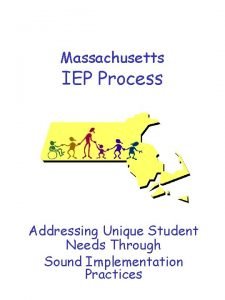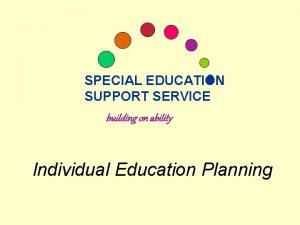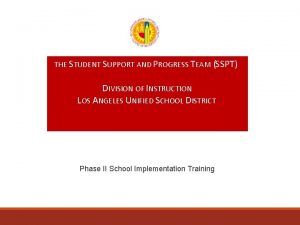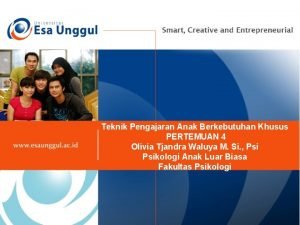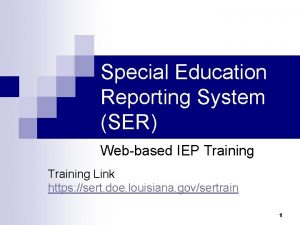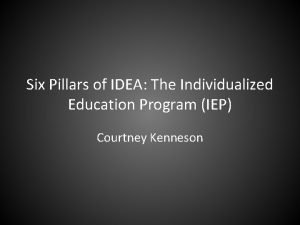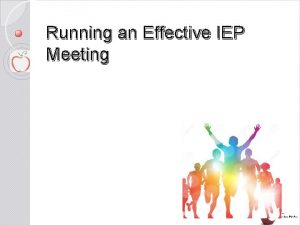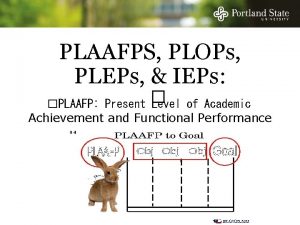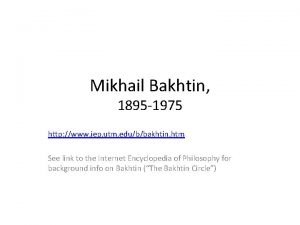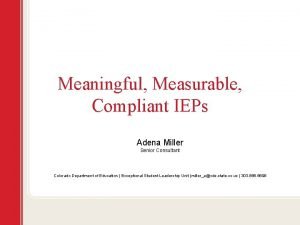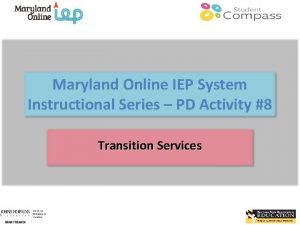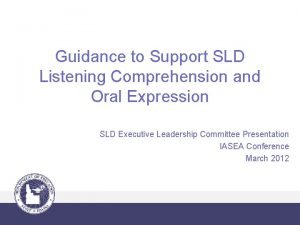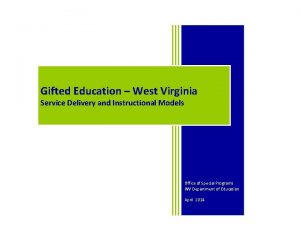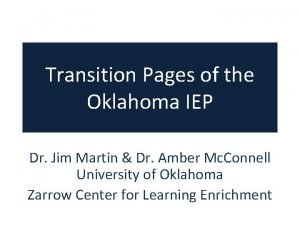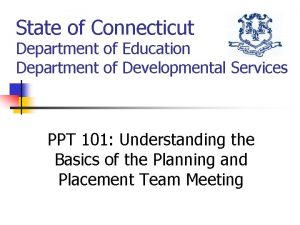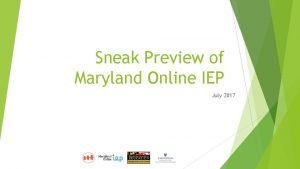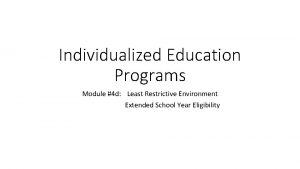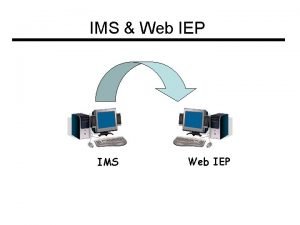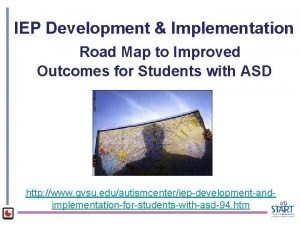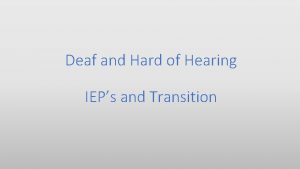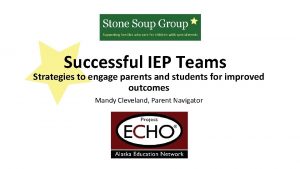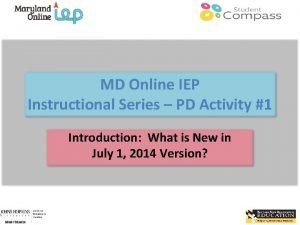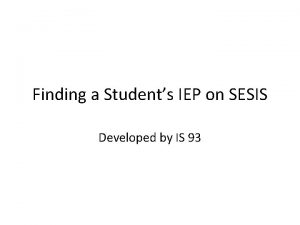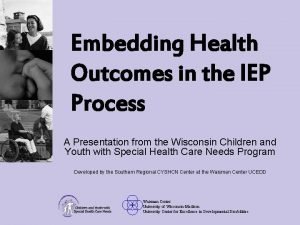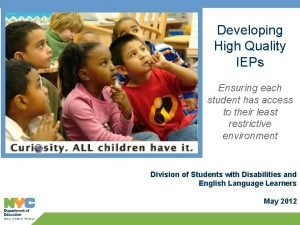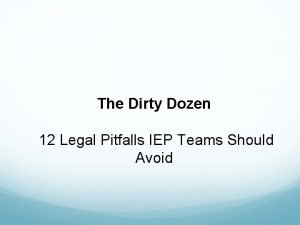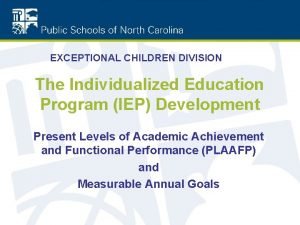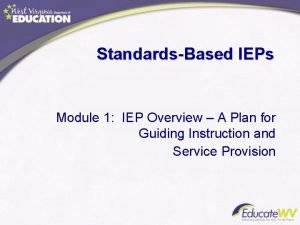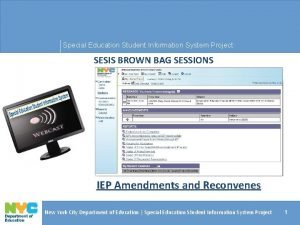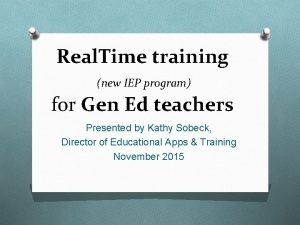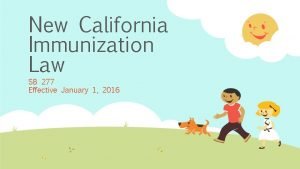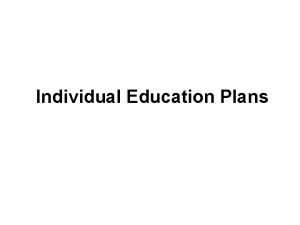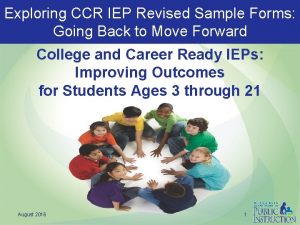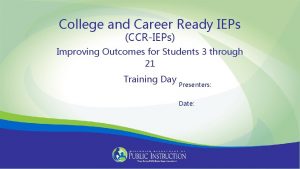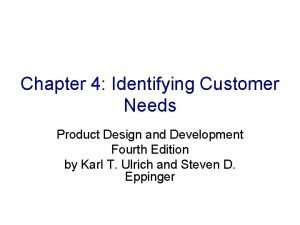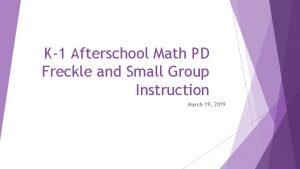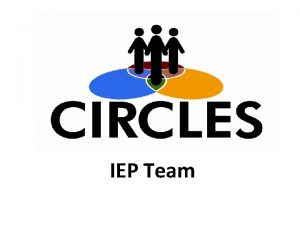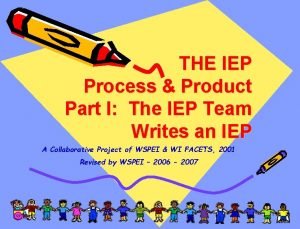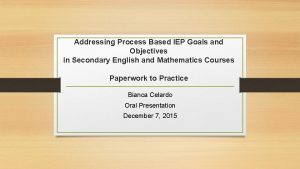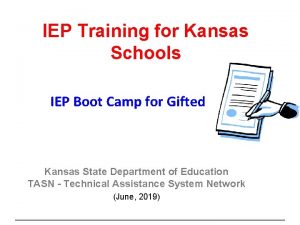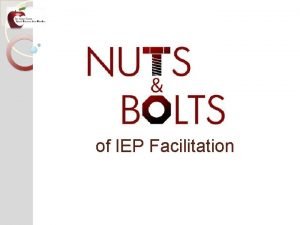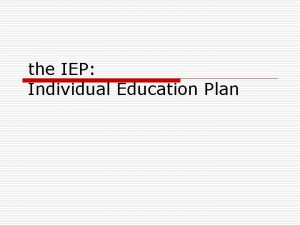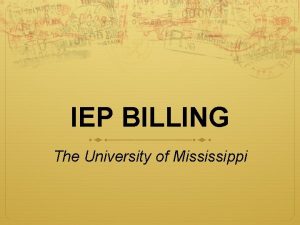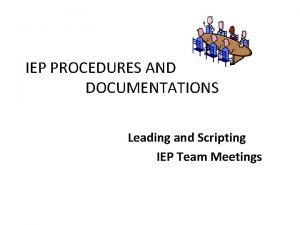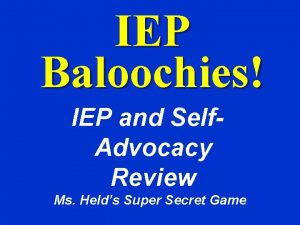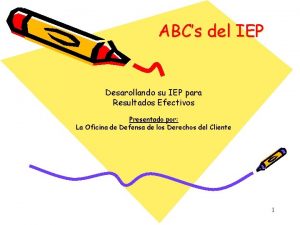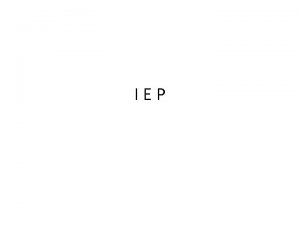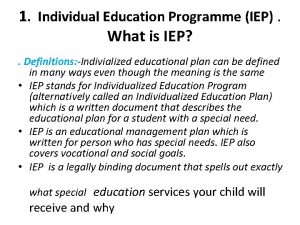The Massachusetts IEP Process Addressing Unique Student Needs

































































































- Slides: 97

The Massachusetts IEP Process: Addressing Unique Student Needs Through Sound Implementation Practices

Massachusetts IEP Process Goal: To better address unique student needs through a greater understanding of the underlying concepts and mechanics of successful Team meetings and IEP development. 1. To increase understanding of school district structures needed to support successful Team meetings. 2. To explore the varying roles of Team members in IEP development: v Enhancing the role of the parents v Increasing student participation in IEP meetings v Improving ongoing educator communication and collaboration v Improving educator preparation, contribution, and participation 3. To provide further guidance on developing student-centered IEPs that are understandable, implementable and comply with regulations. 4. To highlight the need for continuous improvement of Team practices. 2

Necessary Conditions For Successful IEP Development Strong and Visible Administrative Support Parents and students as Active and Informed Partners Effective School Practices Ongoing and Meaningful Staff Development Activities Open and Genuine Effective Collaboration and Communication 3

Effective Team Practices 1. Think About The Individual. Remember that each student has individual needs, based upon the impact of his/her disability. Each IEP should reflect the individual nature of the student. 4

Effective Team Practices 2. Think Education. An IEP should discuss how an individual student’s disability(ies) impact education and concentrate on offsetting or reducing the resulting problems that interfere with the student’s learning and educational performance in the general curriculum. v Think results v Think access to the MA Curriculum Frameworks v Think non-academic and the life of the school 5

Effective Team Practices 3. Think Roles And Role Clarity. v Parent Participation v Student Participation v General And Special Education Teachers v Related Service Providers v Other Staff 6

Regulatory Intent Regarding Parents and Students IDEA 2004 emphasizes a collaborative approach to making important educational decisions for students with disabilities. The law expects school districts to bring together: v Parents v Students v General educators v Special educators v Other professionals, as needed With the combined knowledge and resources of these individuals, students will be assured greater support and subsequent success. 7

Parents! v Parents are equal partners in the Team process. They have a right to be involved in meetings that discuss the identification, evaluation, IEP development and educational placement of their child. v Parents have unique and critically important perspectives on their child’s learning style, strengths and needs. v Every effort should be made to build trust, respect and understanding in an effort to meet the unique needs of the student. 8

Parents! Suggested Practices To Increase Parent Participation: v Make available evaluation material in advance, asking parents to develop a list of questions and/or concerns. v Contact parents in advance of meeting to discuss their concerns or to ask them to come in a few minutes before the meeting to discuss their concerns. v Provide parents with a seating plan or use name tags. v Introduce and refer to all Team members in the same manner. v Use a conference call or Skype during a Team meeting if scheduling a face-to-face is difficult. 9

Students! v Student participation is important and, beginning at age 14, required. Students should be considered important members of the Team and should be driving the process by identifying their own postsecondary goals. v As students get older they should become more and more active within the Team meetings, and increase their leadership by communicating their interests and preferences as well as determining the direction for the identified annual IEP goals in the IEP. v Students are invited to attend Team meetings beginning at the age 14 or younger. See DESE Advisory on the use of the TPF to create Vision and IEP goals for students ages 14 and older. 10

Students! Practices To Increase Student Participation: v Give students opportunities to think about their preferences, goals, and concerns before they enter high school. v Teach students their civil rights. v Help students develop self-advocacy skills. v Have students lead their own Team meetings/role-play. v Invite representatives from adult agencies and college Disability Support Services to speak to student groups about provided services and eligibility requirements. 11

Increased Focus on Student Participation v Students need to be engaged in the IEP Team process early – age 14 is the requirement but prior to attending, training should be provided. v Parents can need help adjusting to their child’s more active decision-making and voice during Team meetings. v School staff need to become comfortable preparing and involving students to become active participants in the IEP process and Teams. 12

The Importance of Educators and Related Service Providers General Educators bring to the Team meeting: v their expertise on the general curriculum. v their knowledge of how the student is progressing in the general curriculum. v their ideas about positive behavioral interventions. Special Educators and Related Service Providers bring to the Team meeting: v their expertise on disabilities, evaluation and assessment v their ability to provide, design, and/or supervise special education services in multiple environments. 13

What to Consider Before the IEP Meeting: General Educator 1. Highlights of General Curriculum 2. Information Regarding General Education Environment 3. Classroom Management 4. Information Regarding Supplementary Aids and Services 5. Information Regarding Administration of State & District. Wide Assessment 14

General Educators as IEP Team Members 1. Share information regarding the general curriculum as it pertains to this student. 2. Share information regarding the general education classroom environment as it relates to the student’s progress in the general education curriculum. 3. Assist in developing effective classroom management techniques. Include positive behavioral interventions if needed. 4. Assist in identifying parent supports, classroom supports, teacher supports and assistive devices needed for this student to be successful. (Think beyond existing services. ) 5. Share information about how this student should participate in state and district-wide assessments. 15

What to Consider Before the IEP Meeting Special Educator 1. Assessment Information - Academic & Behavioral Data 2. Information Regarding Present Level of Educational Performance (PLEP A & PLEP B) 3. Suggestions Regarding IEP Goals 4. Information Regarding Supplementary Aids and Services 5. Information Regarding Administration of State & District. Wide Assessment 6. If student is age 14 or older, assessment information for the secondary transition planning process. 16

Special Educators as IEP Team Members 1. Share information about key evaluation results including progress toward IEP goals (bring work samples, data, baseline info, etc. ) 2. Share information regarding accommodations to the general curriculum and specially designed instruction; share the continued need for the accommodations and suggestions for expanding inclusion with nondisabled students. 3. Propose goal focus for each IEP goal related to the disability’s impact listed in the PLEP; for students 14 and older related goal focus reflects skills listed in the TPF related to the PS Vision. 4. Share parent and classroom supports and assistive devices needed for this student to be successful and independent. 17 5. Share information about the student’s participation in state and districtwide assessments.

What to Consider Before the IEP Meeting Related Service Provider 1. Assessment Information – Therapeutic Data Linked to Instruction and Behavioral Issues in all educational environments 2. Information Regarding Present Level of Educational Performance (PLEP B) 3. Suggestions Regarding Focus of Student’s IEP Goals – Discuss Service Specific Issues 4. Information Regarding Supplementary Aids and Services 5. Information Regarding Administration of State & District. Wide Assessment 18

Related Service Providers as IEP Team Members 1. Share information about key evaluation results including progress toward IEP goals; bring data, baseline pre-post info to show progress toward generalization and independent use of strategies outside of sessions. 2. a: Share information regarding Present Level of Educational Performance (PLEP) in your focus area. b: Share information regarding accommodations to the general curriculum and specially designed instruction. Include suggestions for maximizing the extent to which the student is educated with nondisabled students. Also include recommendations regarding related services and special equipment and devices to be provided to the student. 3. Assist the Team in developing measurable IEP goals and objectives or benchmarks. 4. Assist in identifying parent, classroom and teacher supports and assistive devices needed for this student to be successful. (Think beyond existing services. ) 5. Share information about how the student will participate in state and districtwide assessments. 19

Required Team Knowledge and Expertise Each Team meeting must also have someone who: is qualified to provide or supervise the provision of specially designed instruction is knowledgeable about the general curriculum has the authority to commit school district resources can interpret instructional implications of evaluation results has knowledge or special expertise regarding the student (at the discretion of parent or district) These roles can be filled by one or more individuals. 20

Additional Expertise For postsecondary transition planning, representative(s) from agency(ies) that is/are likely to be responsible for providing/paying for transition services. For meetings where placement will be discussed, a person who is knowledgeable about placement options. 21 Team members can wear more than one hat!

On to the IEP. . . IEP development relies on the judgments of Team members. 22 No two Teams will respond alike. No two Team meetings will be alike.

An IEP is a contract between the parent and school district that. . . considers the individual needs of the student: describes how the student learns focuses on what will make the biggest difference for the student in the next year describes how the school staff will help the student learn better guides a logical decision making process and reflects the decisions of the Team 23

Individualized Education Program Remember that: Every student is different. No two IEPs will be alike. There is no single correct way to write an IEP. Remember to: Write in clear, understandable language. Use a style that best reflects Team decisions. 24

IEP Checklist and IEP Form IEP Checklist – see reference tool reviews items to be included in each IEP section lists regulation citations IEP Form – see communication tool designed to assist Team reviewing all required IEP elements designed to assist Teams in documenting their recommendations 25

IDEA 2004 IEPs for all students must include a statement of measurable annual goals, including academic and functional goals. Benchmarks or short-term objectives must be included in an IEP for a student with significant cognitive disabilities. [P. L. 108 -446, Section 614(d). ] The Department requires school districts to continue to use benchmarks or short-term objectives for all students to address the federal requirement for describing how progress will be measured. 26

Six Basic Principles Federal and state special education law are grounded in six basic principles. 27

The Six Principles 1. Parent and Student Participation 2. Free and Appropriate Public Education (FAPE) 3. Appropriate Evaluation 4. Individualized Education Program (IEP) 5. Least Restrictive Environment (LRE) 6. Procedural Safeguards 28

Individualized Education Program All of the Pieces Fit Together 29

Sample IEP Statements Written to assist Teams in developing IEPs. Written to demonstrate the following: (a) that Teams may use a variety of styles to communicate their intent; (b) that Teams must avoid the use of educational jargon and “just” scores. 30

Access to the General Curriculum and Life of the School Ac ng ssi ces Other Curriculum Areas ce Ac sin g Curriculum Frameworks Vision, Concerns & Assessments g Ac g ce sin ss in s ce Ac Accommodations IEP Goals Specially Designed Instruction and/or Related Services 31

IEP 1 Parent and/or Student Concerns Student Strengths and Key Evaluation Results Summary Vision Statement (Remember the process for developing the Vision and the goal focus changes at age 14+) 32

Examples of: Parents and/or Student Concerns IEP 1 Example 1: a. wants to see Sam’s reading skills improved by the end of the year b. wants to see Sam participate in after school activities Example 2: Concerned about after graduation plans: (1) Will Juan be prepared for work? (2) Will Juan be prepared to continue his education after high school? Example 3: v Kenya’s mother and father are concerned with her overall school progress. She does not seem to be keeping up with her classmates and her IEP goals are not consistently being met. Perhaps she needs different strategies and/or services to improve her performance? 33

Examples of: Parents and/or Student Concerns IEP 1 Example 4: Communication skills: with teachers and peers; need for additional inclass supports; reinforcement of skills through home activities Example 5: * When will Joanne be ready to return to Brown School? * What sort of transition planning will be done and what help will Joanne receive once she returns? 34

Examples of: Student’s Strengths and Key Evaluation Results Summary IEP 1 Example 1: Jose participates in appropriate activities with his 7 th grade classmates. He responds to staff requests. He likes being active and helping others. Jose has at least average intelligence and a communication disability. His speech is clear and easily understandable but he has difficulty expressing his thoughts. His vocabulary and word finding skills are below age/grade expectations. His teachers take time to make sure they understand Jose but his peers may not. Recent evaluations confirm his communication impairment and indicate his reading and calculation skills are solidly within grade level expectations. His recent Career Cluster assessment showed his interest in careers that let him interact with others, be a member of a team and work in a setting where he would have a variety of duties that can change. His “Dream Sheet” states he would like to get an apartment with a couple of his friends, own his own car and 35 travel to the Grand Canyon for fun. Jose reports that he understands his disability but doesn’t like to tell people about it.

Examples of: Student’s Strengths and Key Evaluation Results Summary IEP 1 Example 2: Strengths: following simple directions and routines, he is outgoing Interests/accomplishments: sports of any kind involving a ball, looking at nature shows and visiting live animal settings Education related details: Autism: Frank could not be assessed using a standardized psychometric instrument at his latest re-evaluation (6/2012; age 10 years 2 months). Clinical and school use of surveys and developmental observations place his receptive language skills at the 52 month. level, expressive language at the 30 month level, his global fine motor skills at the 66 month level, his social skills at the 34 month level, and his ability to be engaged in a preferred task for up to 10 minutes with 3 cues while his independent focus ranges from 2 – 4 minutes with up to 5 cues. His eye contact can be maintained 36 during therapy or direct instruction with verbal reminders.

Examples of: Student’s Strengths and Key Evaluation Results Summary IEP 1 Example 3: v attends school regularly and comes to courses/classes prepared; v responds well to a structured behavior management system; v enjoys hands-on learning activities; v won honorary mention in recent science fair, lead singer in school chorus, loves animals and volunteers in an animal shelter; v inconsistent performance over school history resulting from sustained, inappropriate feelings/behaviors (Emotional Impairment); v Angelina has made limited general education course mastery and MCAS results despite strong average abilities and executive function skills; v less achievement towards IEP goals than expected even with an increase of counseling and in-class support last year. 37

Examples of: Student’s Strengths and Key Evaluation Results Summary IEP 1 Example 3 (continued): v review of Angelina’s assessments indicates she is very competent in the areas of personal care, social skills and communication. Less well developed are the underlying skills necessary for employment and independent living. She is still learning to deal with her disability and self-advocacy skills are at the emerging level. v because she is entering the 11 th grade completely dependent on adults in her environment for behavioral structure and setting parameters on her response to adult directives, assessment results continue to indicate a need for a 5 th year or more to ensure her ability to self-manage her behavioral responses to nonpreferred situations. v her personal goal continues to be attending a 4 year college, living at the college and pursuing a career related to a degree in animal science such as breeding or veterinarian support. 38

Student’s Strengths and Key Evaluation Results Summary IEP 1 Reminder To ensure all IEP readers can obtain a comprehensive overview of student assessments and skills, the DESE recommends that all transition assessment information should be listed on IEP 1, so that the narrative includes: v the student’s educational performance; v the student’s functional performance; v The student’s strengths; v The student’s needs; v The student’s progress towards goals; v The student’s personal attributes and accomplishments. Note: When reporting evaluation results in terms of scores, ensure that scores are 39 related to skills so PLEP information links to skill deficits reported in sections of IEP 1.

Examples of: Vision Statement IEP 1 Example 1: The Team would like to see Elena enter an inclusive kindergarten program when she reaches age 5 without reliance on her current 1: 1 paraprofessional. Example 2: By the time Rose is in 2 nd grade, we can see her taking the bus to school and walking independently through the school building. Example 3: We hope Kim’s medical condition will be stabilized so that her access and involvement with school and typical peers can increase. 40

Examples of: Vision Statement IEP 1 Example 4: Pedro wants to be a reporter on the school newspaper and wants to take as many courses as possible to improve his writing skills. He sees himself writing a book in the future. Example 5: (Post-secondary TPF Vision Statement) Sean loves automobiles and spends after school and summer around cars because his goal after graduation is to work as an auto mechanic at a foreign car dealership. He wants to go to a company-specific car mechanics program. Once he gets a job, he wants to live in an apartment with friends. He plans on continuing to play baseball in a local adult league. 41

Examples of: Vision Statement IEP 1 Example 6: (Post-secondary TPF Vision Statement) Brittany wants to go to a 4 year out of state college but is unsure of what she might want to study once she is there. She is interested in art and music and would like to get a job related to one of those fields after college. She plans to live in a dorm, then an apartment and eventually would like to own her own home. 42

IEP 2 Present Levels of Educational Performance (PLEP) PLEP A: General Curriculum Affect of Disability on Progress Accommodation(s) Specially Designed Instruction 43

Example 1: PLEP A: General Curriculum IEP 2 Curriculum Areas: All Impact of Disability on Progress: Jorge is able to write simple sentences but requires teacher assistance or prompts to add detail to his work and to correct mistakes in spelling, grammar and punctuation. He writes slowly and laboriously even using a pencil grip, lined paper and a slightly tipped desk top which means he takes a longer time to complete written assignments than expected. When he makes a mistake he crumples the paper rather than correct it and continue. When he uses word processing he types very slowly and reacts poorly to editing highlights. As Jorge tires during the completion of lengthy assignments, his work products become more disorganized and difficult to follow. He has great difficulty organizing his ideas into written form. 44

Example 1: PLEP A - General Curriculum IEP 2 Accommodation(s): v v pencil grip, large-lined paper, slanted desk top use of word processor for written assignments extra time for written assignments embed expository writing strategies linked to SDI Special Designed Instruction: v Methodology/Delivery of Instruction: Scaffolded strategies for use of organizers for narrative, descriptive, persuasive writing with immediate feedback for error/length comparisons. v Performance Criteria: Modify length of written assignments to include some practice of each concept but not to include overly repetitive practice; plan assignments that allow Jorge to respond verbally or through project-based activities (e. g. , building a model or filming a video). 45

Example 2: PLEP A - General Curriculum IEP 2 Curriculum Areas: Mathematics Impact of Disability on Progress: Tony: v is able to compute addition, subtraction, multiplication and division problems and he has a good memory for shapes and objects but he has difficulty understanding what is asked of him when asked to problem solve. v is very slow in his efforts, as his inability to break down the task causes him anxiety and often stops him cold; he can refuse to continue with a math or any other task that he sees as too challenging; v cannot currently independently apply strategies to tasks without 46 prompting and repeated modeling.

Example 2: PLEP A - General Curriculum IEP 2 Accommodation(s): v v Use of manipulatives (coins, base ten blocks, tanagrams…) Multiple examples and observed use of examples prior to tasks Modified homework assignments with expansions Extra time for standard assessment assignments Special Designed Instruction: v Methodology/Delivery of Instruction: Provide visual information (pictures, charts, graphs…) that reinforce the concept being taught and support generalization to classroom activity; pair Tony with peer or in small groups to solve problems where he will have the opportunity to hear the questions other children ask, and do more independent problem solving; individualized instruction to help Tony visualize the math problem (have him draw pictures, tell stories that incorporate the problem 47 being solved) and check for strategy generalization to classroom assignments. v Performance Criteria: In addition to the standard classroom evaluations, Tony should be allowed to present responses visually and with manipulatives.

Example 3: PLEP A - General Curriculum IEP 2 Curriculum Areas: All Impact of Disability on Progress: v Her ability to understand spoken language is below that of her typical age/grade peers. v She has difficulty learning to pronounce words, reading grade level material, paying attention and understanding oral directions and learning new information. v She becomes frustrated when she cannot express herself in a clear and easily understood manner and becomes angry when corrected. v More able to give complete responses when reminded to use newly learned articulation skills and when asked to pause to think through answers before speaking, though has low tolerance for assistance. v May give up easily and refuse to complete work when upset. 48 v May ask to leave the classroom to go to the Nurse’s Office when classroom demands accumulate and become too stressful.

Example 3: PLEP A - General Curriculum IEP 2 Accommodations: v Embed language production strategies and behavioral reinforcements across class activities. v Identify non-verbal prompt to assist her to avoid singling her out when she struggles to communicate. Specially Designed Instruction: v Content: Pre-teach new vocabulary words and concepts; provide study sheets in all curriculum areas; plan routine review of all major unit concepts (especially before tests and quizzes) v Methodology/Delivery of Instruction: Provide strategies for introduction of new or unfamiliar activities; ask for directions to be repeated back to assure understanding; provide ongoing praise and periodic activity-time reward for work completion; send home weekly report to parents on progress and classroom behavior to ensure reinforcement 49 v Performance Criteria: Test only on vocabulary and concepts included on study sheets; have a series of grading options/activities to choose from at the completion of every major curriculum unit.

Example 4: PLEP A - General Curriculum IEP 2 Curriculum Areas: All Impact of Disability on Progress: Dan’s emotional impairment has the following impacts on his learning: 1. 2. 3. 4. 5. 6. Inability to muster needed energy to focus/complete academic tasks; May become focused periodically on perfection/blow up when not possible; Becomes frustrated, anxious and easily disappointed over not meeting personal academic expectations and perceived criticism of his performance; Inconsistent effort and school attendance has resulted in splinter skills masking actual skill deficits; Cannot self-manage behavioral responses so requires calming and de-escalation strategies when he becomes overwhelmed; Cannot defer or view long-term outcomes so without immediate feedback and 50 support may lose sight of eventual payoff (e. g. , report card grades, progress reports).

Example 4: PLEP A - General Curriculum IEP 2 Accommodations: v Send to Nurse’s Office right before lunch break for his medication. v Notify Guidance Counselor if Dan puts his head on his desk and refuses to participate in class or behaviorally escalates. v Establish signal for him to opt out of potentially challenging social or academic situations. v Provide staff training to ensure consistent responses to emerging issues and challenging behaviors. Specially Designed Instruction: v Content: Don’t assume his mastery of easier content/concepts – pretest knowledge and understanding of entire class rather than single Dan out. v Methodology/Delivery of Instruction: Break assignments into step by step pieces and assign gradually over time; assist Dan in developing time management strategies (daily planner and schedule); provide reinforcement for assignment completion and teach selfmonitoring strategies. 51 v Performance Criteria: Grade assignments as soon after completion as possible; have Dan complete assignments in daily planner; meet with Dan weekly to review achievement if he is completing work as assigned; meet daily with Dan if work completion begins to lag or to address his concerns around performance.

IEP 3 Present Levels of Educational Performance (PLEP) PLEP B: Other Educational Needs Affect of Disability on Progress Accommodation(s) Specially Designed Instruction 52

Example 1: PLEP B - Other Ed. Needs IEP 3 Other Educational Needs: Behavior Impact of Disability on Progress: Carl's coexisting diagnosis of Oppositional Defiance Disorder (ODD) in combination with the impact of his AD/HD issues creates a situation in which he can, at times, react to relatively subtle or adult informational interactions by exhibiting behaviors that reflect components of ODD: losing his temper, arguing with adults, active defiance or refusal to comply with adults' requests or rules, seeming to deliberately annoy people, blaming others for his mistakes or misbehavior, being touchy or easily annoyed by others, becoming angry or resentful or seeming to act spitefully. These behaviors are exhibited by Carl more frequently than in other students his age and cause significant 53 impairment in social, academic, and independent functioning.

Example 2: PLEP B - Other Ed. Needs IEP 3 Accommodations: Carl requires positive behavioral supports to foster successful social behavior and academic gains. He needs clear, consistent consequences for inappropriate behaviors, positive contingencies for appropriate behaviors and a team-based approach across settings to ensure consistency of responses by adults. Specially Designed Instruction: v Content: Carl's instructional services include an emphasis on building and practicing collaborative problem solving skills which includes brainstorming and role playing to identify possible solutions, how to negotiate, make decisions, and implement solutions in a variety of settings. Carl must learn functionally equivalent responses to create a repertoire of skills that he can rely on rather than rule breaking or opposition v Methodology/Delivery of Instruction: Modeling, social scripting and role playing between Carl and his counselor. v Performance Criteria: Comparison of monthly data to current event baselines. 54

Example 2: PLEP B - Other Ed. Needs IEP 3 Other Educational Needs: Adapted Physical Education/Gross Motor Skills Impact of Disability on Progress: Tyler is physically active but his lack of upper body strength and coordination as well as limited range of motion and stamina impacts his ability to participate in preferred sport activities including swimming and basketball. 55

Example 2: PLEP B - Other Ed. Needs IEP 3 Accommodations: v Adapt physical activities to enable his full participation. v Preview activity components with PT to enable Tyler to practice privately prior to large group participation. Specially Designed Instruction: v Content: Participation in typical physical education class but modified and supplemented by PT and APE teacher as listed in attached doctor’s orders. v Methodology/Delivery of Instruction: Stamina and endurance as well as range of motion therapies designed and monitored by Physical Therapist and reinforced in physical education class. v Performance Criteria: Graded on participation and effort in gym activities as well as skill improvement 56 in modified activities.

Pieces of the IEP Puzzle A. IEP 1 - Student Strengths and Key Evaluation Results Summary B. IEP 2 & 3 - How does the disability(ies) effect progress (PLEP) C. IEP 2 & 3 - Accommodations/ Specially Designed Instruction D. IEP 4 - Goals/Objectives/Benchmarks E. IEP 5 - Service Delivery Grid F. IEP 6 - Non-participation Justification G. IEP 7 - State and District-wide Assessment 57

IEP 4 Goal # and Specific Goal Focus – Skill, NOT Setting Current Performance Level Measureable Annual Goal – 2 sections Measureable Objectives/Benchmarks 58

Measurable Annual Goals Three Key Concepts: v A Goal Must Be Skill Building v A Goal Must Contain a Target Behavior, Condition and Criteria. v There Must Be a Data Collection Strategy that Supports the Measurability of the Goal. 59

Key Concept #1 In order to access, participate, and make progress in the general curriculum and the life of the school, A Goal Must Be Skill Building. 60

What skills does the Student need to develop in order to access, participate and make progress in the general curriculum and the life of the school? Measurable Annual IEP Goal 61

Goal Focus A goal must focus on an area of need that will make the biggest difference to the student. 62

Goal Focus: Skill Building Memory Communication Time Management Self Advocacy Self Regulation Organization 63

Sometimes v Reading v Writing v Mathematics Are Skill Building 64

Services and Goals Occupational Therapy, Counseling, Speech Therapy, Physical Therapy. . . Reminder: Goals are written to reflect what the student will do, not what service is provided. 65

Key Concept #2 Measurable Annual Goal Components v Target Behavior - The skill or behavior in need of change. v Condition – The circumstances under which the target behavior is to occur. v Criteria – the acceptable level of performance of the target behavior. 66

Measurable Annual Goals (Target Behavior, Condition, Criteria) v Nadia will identify types of sentences (simple, compound, complex) when editing, scoring 3/4 on the MCAS Scoring Guide for Standard English Conventions. v Monday through Friday, Jill will use the public transportation system to get to and from her job placement, independently arriving at work on time, for any five consecutive days.

Measurable Annual Goals (Target Behavior, Condition, Criteria) v Through participation in a career exploration course, Max will identify potential career fields of interest and chart a preparation/educational plan required for entry into those fields. v Given a structured social activity, with the opportunity to have all his ideas conveyed accurately, Max will independently use language in an age appropriate manner to communicate with peers and teachers. 68

Measurable Annual Goals (Target Behavior, Condition, Criteria) v When given a topic in History, Social Sciences, English Language Arts or Science and Technology, Jose will be able to independently write a three-paragraph essay containing the required elements; introduction, supporting details, and conclusion. 69

Measurable Annual Goals (Target Behavior, Condition, Criteria) v When provided with a graphic organizer and a checklist of materials, Max will develop the organizational skills to independently record his homework assignments in English Language Arts, Math, Social Studies and Science. v In a consumer education course, with adult assistance, Max will design a financial plan that includes managing income and credit, and saving to achieve financial goals. 70

Goal Focus: Money Management Skills CPL: Currently Mavis is able to complete math computation at grade level. She is able to read newspapers and classifieds and draw accurate information from them. She has developed personal goals related to post-secondary education and has completed applications to several settings. Goal: Given instruction and practice with a variety of life skill areas and models, Mavis will design a personal financial plan that includes managing costs, income and credit, and saving to reach her post-secondary goals. How will we know that the student has reached this goal? As a component of the grade 11 Consumer Education course Mavis will produce a 12 month personal budget projection that includes living expenses against income for 2 of her post-secondary options.

Current Performance Levels Measurable Annual Goals IEP 4 Goal #: 3 Specific Goal Focus: Attention Skills Current Performance Level: During the past 2 marking periods Joe has submitted an average of 41% of his required homework and classroom assignments. He can explain the elements of an instructional activity but is off-task for an average of 10 out of 18 minutes per activity unless an adult is 1: 1 at his side. He requires a minimum of at least 3 prompts and constant refocusing to begin most tasks. He can be engaged in a task he finds challenging for up to 8 minutes with vigilant adult prompting and feedback. Measurable Annual Goal: Given a maximum of 2 verbal prompts, Joe will engage in and accurately complete a non-preferred, small-group activity and/or independent assignment, without protest, and remain on task with no avoidance (bathroom requests, 72 crumpling work and restarting, humming, talking at classmates) for at least 20 minutes , in 3 out of 4 trials, as measured by bi-weekly staff documentation and analysis of work products by special educator and Liaison.

Current Performance Levels Measurable Annual Goals IEP 4 Goal #: 4 Specific Goal Focus: Communication Skills Current Performance Level: Lisa has the physical capacity to produce speech sounds but a verbal vocabulary limited to ten words. When she speaks, she most commonly uses the following words: “yes”, “no” and “hi”. She inconsistently and with up to 5 adult cues per attempt uses eye gaze and single switches to communicate with others. Her combined vocabulary using all three methods of communication totals 18 words. Measurable Annual Goal: When assessed on the use of her verbal vocabulary, eye gaze use and single switch use, Lisa will demonstrate spontaneous correct usage of a minimum of 30 vocabulary words, 12 new ones jointly selected by her family and the language pathologist. 73

Measurable Objectives break the Measurable Annual Goal into discrete components that are short-term, measurable, intermediate steps. To ensure measurability, each objective should have a Target Behavior, Condition, and Criteria. 74

Examples of Objectives v Given teacher models and strategy instruction, using his graphic organizer, Max will develop a system to record, analyze and review data. v With practice and no more than 3 cues, Max will research and collect information/data on 4 career fields of interest to him. v Using models and no more than 2 prompts, Max will outline career related requirements, opportunities and related factors ( diversity of careers, wages, growth projections, academic requirements, and working conditions) appropriate for the 4 career fields of interest to him. v Max will independently identify 2 potential career fields of interest and chart a preparation/educational plan required for entry into those fields. 75

Measurable Benchmarks break the Measurable Annual Goal into major milestones that the student is expected to reach within a specified period of time. To help ensure measurability, Benchmarks may also have Target Behaviors, Conditions, and Criteria. 76

Examples of Objectives v By the end of the 1 st quarter, when provided with cues, Max will stay on topic while engaged in a conversation with one or more peers in five consecutive language activities. v By the end of the 2 nd quarter, given a class setting, Max will initiate social interactions with at least 1 other student in one activity for three consecutive weeks. v By the end of the 3 rd quarter, with teacher cues, Max will consistently use the pragmatic skills of active listening, commenting, asking questions, and appropriately entering and exiting conversations. v Goal: By the end of the 4 th quarter, given a structured social activity, with the opportunity to have all his ideas conveyed accurately, Max will 77 independently use language in an age appropriate manner to communicate with peers and teachers.

Key Concept #3 Check for Measurability The Team must discuss what Data Collection Strategy will be used to measure the progress toward reaching this goal. The discussion should answer: v What data will be collected? v What is the source of the data? v What is the data collection schedule? v Who will collect the data? 78

Data Collection Strategy v Data to be Collected Specific to goal, to the student, to the environment v Data Collection Sources Examples: rubrics, checklists, observation, record of verbal responses, portfolios, shortened tests, open book tests, teacher-made tests, illustrations, reports/observations from internships and vocational experiences, hands-on performance, self-evaluation v Data Collection Schedule Examples: quarterly, by mid-year, monthly, 30 consecutive days, last week of each month v Data Collection Person Examples: general educator, special educator, related service provider, aide, student 79

Final Steps in the Process Measurable Annual Goals, Objectives, Benchmarks Now the Team can complete the process and finish the data collection discussion: v What is the source of the data? v What is the data collection schedule? v Who will collect the data? 80

The Progress Report Answers the following question: What is the student’s progress towards meeting the annual goal? Assures the parent that the student’s learning is continuous. 81

The Complete Package 1) Goal Focus 2) Current Performance Level 3) Measurable Goals Target Behavior/Condition/Criteria v Data Collection Strategy: What - information collected Where - the source of the data When - collection schedule Who person(s) responsible for data collection 4) Objectives/Benchmarks Target Behavior/Condition/Criteria 5) Progress Reports Information from Data Collection 82

IEP 5 Service Delivery Grid A: Consultation (Indirect Service) Grid B: Special Education and Related Service in General Education (Direct Service) Grid C: Special Education and Related Service in Other Settings (Direct Service) 83

Things To Remember: Service Delivery IEP 5 Don’t think only of existing services within a setting. Do think of services needed to meet the IEP goals. Don’t think only of student needs. Do think of what support services are needed by staff and/or parents to help meet the IEP goals. Don’t use generic terms like “sped staff”. Do use titles/roles indicating who will deliver the services. Don’t use “as needed” to indicate frequency. Do give precise details to show duration and amount. 84

IEP 6 Nonparticipation Justification Schedule Modification Transportation Services 85

Nonparticipation Justification IEP 6 Example 1: (removed for all curricular subjects) needs a small, structured classroom with routine and systematic rewards v to reward on-task, appropriate behavior v to control angry outbursts Example 2: (removed for all subjects) Tomas requires daily ASL instruction and continuous practice in use of ASL skills to improve communication skills with ongoing opportunities for ASL interaction with peers and adults. Example 3: (removed from in-district programs) Given the intensity and unpredictability of Khloe’s aggressive and unsafe reactions to real or perceived difficulties with academic challenges or social interactions she requires removal from her community school setting and services provided within a 24 hour therapeutic residential setting. 86

Nonparticipation Justification IEP 6 Example 4: (removed for entire school day) Joshua’s significant medical and physical needs* require his participation in a highly specialized, responsive program setting. Example 5: (removed for physical therapy) Susan’s degenerative neuromotor issues* require direct physical therapy services in a private setting equipped with specialized equipment. Example 6: (removed for all subjects) Tina’s significantly disruptive behaviors throughout the day* require intensive behavioral intervention in a highly structured small group setting until she is better able to safely and consistently self-manage her responses to nonpreferred directives. 87 *documented in the IEP using data from appropriate, individualized assessments

Schedule Modification IEP 6 Example 1: (shorter day) Based on the directions of her physician, Amy will initially transition back to the school setting for 4 hours each day. Her schedule will be changed to ensure she receives access to all general curriculum areas before she goes home. Example 2: (longer day) -extra hour on Tuesday and Thursday for Braille instruction scheduled after school to provide continuity of service delivery to Juanita without loss of instructional time. -Braille instructor will monitor her use of Braille by contacting teachers on a monthly basis. 88

Schedule Modification IEP 6 Example 3: (shorter year due to reoccurring health problem) v school schedule will be modified to accommodate Sam’s reduced stamina during chemotherapy treatments; v home/hospital tutoring will be provided for 6 hours a week if doctor concurs that Sam is able to participate; v if Sam is not able to participate, her special educator with general educator assistance will modify major subject content requirements and grading criteria; v guidance counselor and school nurse will be responsible to routinely contact parent, physician, school staff and home/hospital tutor to monitor her progress. 89

Schedule Modification IEP 6 Example 4: (longer year) v see IEP 5 / services with start date: 07/01 and end date: 08/01 v documented severe regression of communication skills v speech pathologist to meet before/after summer program with summer program staff 90

Transportation Services IEP 6 Example 1: No / Regular transportation Discussion (not written in IEP): Joe ‘s disability does not prevent him from being transported to school like any other student. After Joe’s IEP is written, the Placement Team determines Joe’s IEP should be implemented in a private day school setting. The school district is responsible for providing transportation to and from the day school. However, this is not considered “special transportation”. 91

Transportation Services IEP 6 Example 2: Yes / Special Transportation On a regular transportation vehicle with the following modifications and/or specialized equipment and precautions: v The bus will pick up/drop off Nicole at the base of her driveway; v her parents have agreed to escort Nicole to/from bus; v an aide will ride bus until Nicole has become familiar with the bus routine (Team anticipates that the aide will be needed for the first month of school. ); v school staff will escort Nicole to/from bus to classroom each day; v bus driver will be introduced to Nicole and her parents prior to first bus ride and will receive a written emergency plan Discussion (not written in IEP): Nicole’s intellectual impairment requires she receive special transportation because she cannot independently or safely access regular transportation as she once was able to. The Team recommends 92 that she ride regular transportation with support to receive a less restrictive transportation service.

Transportation Services IEP 6 Example 3: Yes / Special Transportation On a special transportation vehicle with the following modifications and/or specialized equipment and precautions: v station wagon; v needs assistance in/out of home and school and on/off vehicle; v aide, with emergency medical training, required for monitoring of seizure condition Discussion (not written in IEP): Jorge has a developmental delay and a health impairment that prevents him from taking regular transportation even with modifications, specialized equipment and/or precautions. Note: Review special transportation requirements in 603 CMR 28. 05(b)(1)(i)-(iii). 93

IEP 7 State or District-Wide Assessment Participates like any other student. Participates with accommodation(s). Takes Alternate Portfolio Assessment. 94

IEP 8 Additional Information including: Other issues related to secondary transition: anticipated graduation date; interagency responsibilities or needed linkages; age of majority transfer of rights; and Chapter 688 Referral recommendation Efforts to obtain parent/student participation, if not in attendance School Assurance Parent Options/Responses 95

Things To Remember: Additional Information IEP 5 v Preparation of students with disabilities for independent living and economic self - sufficiency is a major focus of IDEA. v Transition planning must begin no later than age 14 and sooner, if appropriate. v Final details in regard to transition planning are recorded on IEP 8 but transition planning begins on IEP 1 and should be reflected throughout the IEP. For students age 14 and older, the TPF Vision Statement and Skills list are first created and then moved to the IEP as Vision and Goal Focus components. v Middle and High School Teams should be familiar with DESE Transition Advisories. v Staff members on IEP Teams should be familiar with DESE Advisory on use of paraprofessionals and 1: 1 aides. 96

It’s a good idea to assess Team practices. v Formal Assessment (through outside evaluator/consultant) v Coordinated Program Review v Informal Assessments 97
 Plep examples
Plep examples Flat addressing vs hierarchical addressing
Flat addressing vs hierarchical addressing Student-led conference script
Student-led conference script Iep process
Iep process Primary needs and secondary needs
Primary needs and secondary needs Satisfaction
Satisfaction Henry murray theory
Henry murray theory Strategic gender needs and practical gender needs
Strategic gender needs and practical gender needs Define need analysis
Define need analysis Iep meeting quotes
Iep meeting quotes Sspt intervention plan sample
Sspt intervention plan sample Contoh iep anak berkebutuhan khusus
Contoh iep anak berkebutuhan khusus Https//serp.doe.louisiana.gov/ser
Https//serp.doe.louisiana.gov/ser 6 pillars of idea
6 pillars of idea Iep meeting agenda
Iep meeting agenda Plaafp
Plaafp Iep utm edu
Iep utm edu Onlineiep
Onlineiep Carol kosnitsky
Carol kosnitsky Iep md online
Iep md online Roles of iep team members
Roles of iep team members Iep meeting agenda
Iep meeting agenda Listening comprehension disability
Listening comprehension disability Iep writer wv
Iep writer wv Iep goal for citing textual evidence
Iep goal for citing textual evidence Oklahoma iep
Oklahoma iep Iep components special education
Iep components special education Marylandonline iep
Marylandonline iep Esy justification statement
Esy justification statement Webiep
Webiep Iep development and implementation
Iep development and implementation Virgen
Virgen Wvde iep
Wvde iep Gifted iep goals
Gifted iep goals Iep
Iep Md online iep
Md online iep What is sesis
What is sesis Iep
Iep Quality services iep
Quality services iep Iep trailer chassis only
Iep trailer chassis only Iep meeting do's and don'ts
Iep meeting do's and don'ts Present levels of performance iep examples
Present levels of performance iep examples Iep
Iep Sesis iep
Sesis iep Realtime iep
Realtime iep Sb277 iep exemption
Sb277 iep exemption Individualized education plan
Individualized education plan Ccr iep
Ccr iep Uri aec tutoring
Uri aec tutoring Iep goal
Iep goal Methods of identifying customer needs
Methods of identifying customer needs What did you do last weekend conversation
What did you do last weekend conversation What did you do in london last weekend
What did you do in london last weekend National clearinghouse student tracker
National clearinghouse student tracker Class maths student student1 class student string name
Class maths student student1 class student string name National student clearinghouse student tracker
National student clearinghouse student tracker Student freckle math
Student freckle math Good morning student how are you
Good morning student how are you Student learning space password
Student learning space password Hát kết hợp bộ gõ cơ thể
Hát kết hợp bộ gõ cơ thể Ng-html
Ng-html Bổ thể
Bổ thể Tỉ lệ cơ thể trẻ em
Tỉ lệ cơ thể trẻ em Gấu đi như thế nào
Gấu đi như thế nào Glasgow thang điểm
Glasgow thang điểm Hát lên người ơi alleluia
Hát lên người ơi alleluia Các môn thể thao bắt đầu bằng tiếng chạy
Các môn thể thao bắt đầu bằng tiếng chạy Thế nào là hệ số cao nhất
Thế nào là hệ số cao nhất Các châu lục và đại dương trên thế giới
Các châu lục và đại dương trên thế giới Công của trọng lực
Công của trọng lực Trời xanh đây là của chúng ta thể thơ
Trời xanh đây là của chúng ta thể thơ Mật thư anh em như thể tay chân
Mật thư anh em như thể tay chân Phép trừ bù
Phép trừ bù Phản ứng thế ankan
Phản ứng thế ankan Các châu lục và đại dương trên thế giới
Các châu lục và đại dương trên thế giới Thể thơ truyền thống
Thể thơ truyền thống Quá trình desamine hóa có thể tạo ra
Quá trình desamine hóa có thể tạo ra Một số thể thơ truyền thống
Một số thể thơ truyền thống Cái miệng nó xinh thế chỉ nói điều hay thôi
Cái miệng nó xinh thế chỉ nói điều hay thôi Vẽ hình chiếu vuông góc của vật thể sau
Vẽ hình chiếu vuông góc của vật thể sau Nguyên nhân của sự mỏi cơ sinh 8
Nguyên nhân của sự mỏi cơ sinh 8 đặc điểm cơ thể của người tối cổ
đặc điểm cơ thể của người tối cổ Thế nào là giọng cùng tên
Thế nào là giọng cùng tên Vẽ hình chiếu đứng bằng cạnh của vật thể
Vẽ hình chiếu đứng bằng cạnh của vật thể Tia chieu sa te
Tia chieu sa te Thẻ vin
Thẻ vin đại từ thay thế
đại từ thay thế điện thế nghỉ
điện thế nghỉ Tư thế ngồi viết
Tư thế ngồi viết Diễn thế sinh thái là
Diễn thế sinh thái là Dạng đột biến một nhiễm là
Dạng đột biến một nhiễm là Số nguyên là gì
Số nguyên là gì Tư thế ngồi viết
Tư thế ngồi viết Lời thề hippocrates
Lời thề hippocrates Thiếu nhi thế giới liên hoan
Thiếu nhi thế giới liên hoan ưu thế lai là gì
ưu thế lai là gì Khi nào hổ mẹ dạy hổ con săn mồi
Khi nào hổ mẹ dạy hổ con săn mồi Khi nào hổ mẹ dạy hổ con săn mồi
Khi nào hổ mẹ dạy hổ con săn mồi
